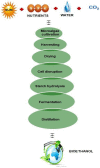Scope of algae as third generation biofuels
- PMID: 25717470
- PMCID: PMC4324237
- DOI: 10.3389/fbioe.2014.00090
Scope of algae as third generation biofuels
Abstract
An initiative has been taken to develop different solid, liquid, and gaseous biofuels as the alternative energy resources. The current research and technology based on the third generation biofuels derived from algal biomass have been considered as the best alternative bioresource that avoids the disadvantages of first and second generation biofuels. Algal biomass has been investigated for the implementation of economic conversion processes producing different biofuels such as biodiesel, bioethanol, biogas, biohydrogen, and other valuable co-products. In the present review, the recent findings and advance developments in algal biomass for improved biofuel production have been explored. This review discusses about the importance of the algal cell contents, various strategies for product formation through various conversion technologies, and its future scope as an energy security.
Keywords: algae; biodiesel; bioethanol; biofuels; biogas; biohydrogen; microalgae.
Figures
References
-
- Afify A. M. M., Shanab S. M., Shalaby E. A. (2010). Enhancement of biodiesel production from different species of algae. Grasas y Aceites 61, 416–422 10.3989/gya.021610 - DOI
-
- Al-Juhaimi F. Y. (2014). Biogas production through the anaerobic digestion of date palm tree wastes – process optimization. Bioresources 9, 3323–3333 10.15376/biores.9.2 - DOI
-
- Awolu O. O., Layokun S. K. (2013). Optimization of two-step transesterification production of biodiesel from neem (Azadirachta indica) oil. Int. J. Energy Environ. 4, 39. 10.1186/2251-6832-4-39 - DOI
-
- Behera S., Mohanty R. C., Ray R. C. (2011). Ethanol production from mahula (Madhuca latifolia L.) flowers using free and immobilized (in Luffa cylindrical L. sponge discs) cells of Zymomonas mobilis MTCC 92. Ann. Microbiol. 61, 469–474 10.1007/s13213-010-0160-y - DOI
Publication types
LinkOut - more resources
Full Text Sources
Other Literature Sources
Molecular Biology Databases




